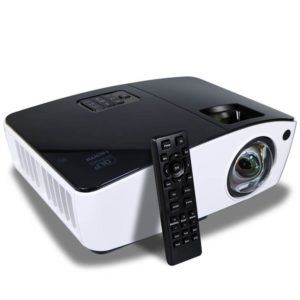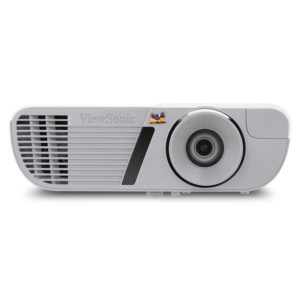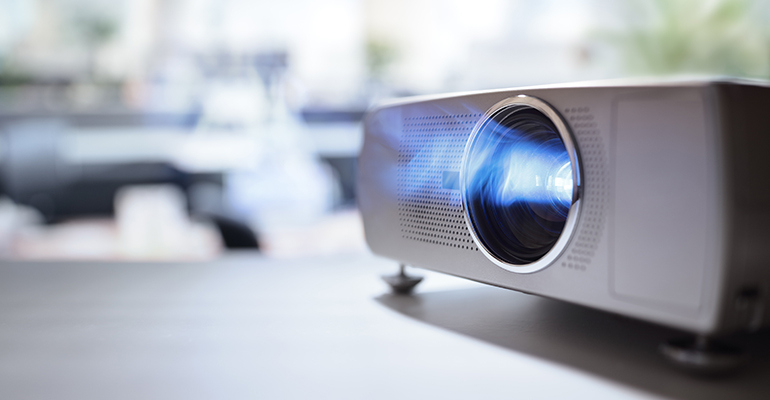You know what a projector is, but do you know what the heck the lens does? Does it have to be a zoom lens or a prime lens? What about the focal length? Does it even matter?
It turns out that it matters a whole lot—and it affects how you should choose the overall projector.
Therefore, we’ve provided everything you should know about projector lenses and which one you should select this year.
Know the Throw Distance
The throw distance is the space between the projector to the screen. You can think of the throw distance as how hard a projector has to work to throw its image onto a far away screen.
Some projectors will be good at throwing their image far away but won’t be flexible to accommodate shorter distances. Others may be flexible but compromise distance.
Know What Your Needs Are
Knowing basic things about how you’ll use your projector influences the type of projector lens you’ll need.
If you know that you won’t be altering the throw distance, then you should get a lens with a fixed throw to width radius. Say you plan on mounting your projector to a ceiling or wall. The fixed throw radius will ensure that you get the best image possible because the projector’s machinery doesn’t have to include other mechanism for shorter distances. You get the most precise image possible with a fixed throw to width radius.
But How Do You Measure the Throw to Width Radius?
There’s a simple equation for you:
Throw Distance / Screen Width = Throw to Width Ratio
If there’s a 20-foot distance on a 10-foot screen, you have a 2:1 throw distance radius. Simple as that. But what if you plan on moving your projector around?
You can’t rely on the fixed throw to width radius so you’ll have to rely on other projector specs. Typically, projector manufacturers will tell you the minimum and maximum throw distance the projector will be able to handle.
Say you’re using two different spaces, one that will have a 40-foot throw distance and a 30-foot throw distance. The screen remains the same in both spaces at 10 feet long.
You’ll use the same throw distance/screen width equation so that will be 4:1 and 3:1 for both spaces, respectively.
This will be your throw to width range. Therefore, when you look up projector specs, you’ll look for 4-3:1 throw to width range. Anything containing that range and you’re good to go.
Remember that the screen size is changeable as well. Let’s say you have a 20-foot difference in two spaces you’ll be using, but the screens are 5 feet and 8 feet long, respectively.
That’s 20 (throw distance) / 5 (screen width), which is 4:1
And 20 / 8 is 2.5.
Therefore, you’ll need a 2.5-4 foot range. Note that the ‘1’ in the 4:1 and 2.5:1 ratio will rarely, if ever, change. No need to worry about that. (However, this kind of throw range is incredibly rare. You’ll usually find projectors in the 1-2:1 ratio range.)
Best Projectors for Short Distances
If you’ll be viewing in a tight space, it’s best to get a projector with a tight throw lens. One of the best ones on the market is the NIERBO Ultra Short Throw Projector.
Ultra Short Throw Projector

If you’re at home or at a business meeting, it’s good to have a projector with a short throw distance. At home, the projector will be able to accommodate most room sizes, as opposed to ginormous movie theaters. In a meeting, you won’t have to worry about standing in front of the projector’s image and blocking it’s view with your shadow, as you’ll probably be standing in front of the projector’s lens.
This NIERBO projector has a 0.565:1 throw ratio and only about 4 feet is needed for it to do the job. The 260W ultra-high-pressure mercury lamp will provide you with 5,000 hours of use, so you won’t have to worry about replacing the bulb any time soon. And, even when you do, replacing it is a breeze. If you’re in need of a projector with a short throw distance, NIERBO is the one for you.
Projectors with a Long Throw Distance
If you’ve got a longer space you need to project in, you need a projector capable of throwing its image across a long distance. That’s going to require a lot of power and a great lens. Luckily, that’s found in the…
ViewSonic PJD7828HDL 3200 Lumens 1080p HDMI Home Theater Projector

This ViewSonic projector accommodates projectors anywhere from 12 feet to 24 feet long. It has a 1.15-1.5:1 throw ratio and can handle distances from 4.2 to 46.9 feet long.
The ViewSonic’s 3,200 lumens lens and 22,000:1 contrast ratio will provide images as you’ve never seen before. Darks will be darker, colors richer and the image will never look washed out or dull. You won’t be able to tell the difference between a cinema experience and the ViewSonic projector.
Best of all, this projector is compatible with HDML MHL, USB Type A, USB mini type B, and VGA inputs so you can watch media from a variety of platforms. Whether it’s your computer, tablet, game console or mobile device, the ViewSonic projector has got you covered.
Let’s review
- When choosing a projector, know the space you’ll be inhabiting. The distance is crucial for deciding what kind of lens you’ll need to get.
- Know screen size, too. That way, you can find the throw distance/screen width ratio you’ll see on almost all projector specs.
- Decide what kind of projector you’ll need for a space—one with a short throw distance or a long throw distance—and find a projector with the lens to accommodate.
- Keep other specs of the projector in mind, such as lumens, contrast ratio, and bulb lifespan when deciding on your projector. In addition, take note of what technology you’ll be hooking up to the projector most frequently (like a computer, gaming console or mobile phone) and be sure that the projector has the hook-up to fit that technology

